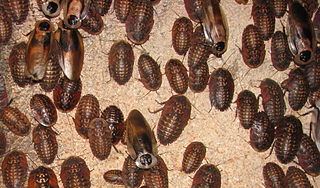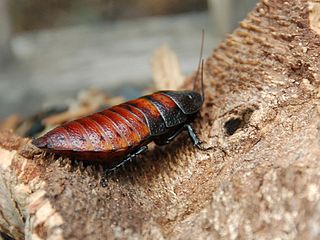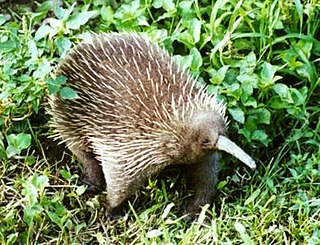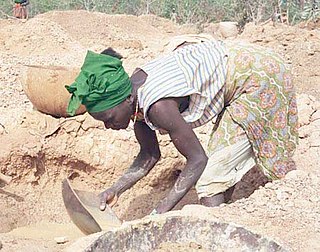Related Research Articles

The economy of Guinea is dependent largely on agriculture and other rural activities. Guinea is richly endowed with good minerals, possessing an estimated quarter of the world's proven reserves of bauxite, more than 1.8 billion tonnes of high-grade iron ore, significant diamond and gold deposits, and undetermined quantities of uranium. In 2021, Guinea was the world's biggest exporter of Aluminium Ore 2021 trade surplus was $4.3B.
The Wopkai people, or Wopkaimin, are a small aboriginal tribe of the Faiwol people that lives in the remote Star Mountains in western Papua New Guinea in what is known as the Fly River socio-ecological region. They speak the Wopkai dialect of the Faiwol language.

Giant cockroaches, or blaberids, are the second-largest cockroach family by number of species. Mostly distributed in warmer climates worldwide, this family is based on the American genus Blaberus, but much of the diversity is also found in Africa and Asia.

Rio Tinto Group is a British-Australian multinational company that is the world's second largest metals and mining corporation. It was founded in 1873 when a group of investors purchased a mine complex on the Rio Tinto, in Huelva, Spain, from the Spanish government. It has grown through a long series of mergers and acquisitions. Although primarily focused on extraction of minerals, it also has significant operations in refining, particularly the refining of bauxite and iron ore. It has joint head offices in London, England and Melbourne, Australia.

The Florida woods cockroach is a large cockroach species which typically grows to a length of 30–40 mm (1.2–1.6 in). When alarmed, adults can eject an extremely foul-smelling directional spray up to 1 m, which inspired several of its other common names: Florida skunk roach, Florida stinkroach, skunk cockroach, skunk roach, stinking cockroach, and stinkroach. Two other naming variations include Florida cockroach and Florida woods roach.

The Madagascar hissing cockroach, also known as the hissing cockroach or simply hisser, is one of the largest species of cockroach, reaching 5 to 7.5 centimetres at maturity. They are native to the island of Madagascar, which is off the African mainland, where they are commonly found in rotting logs. It is one of some 20 known species of large hissing roaches from Madagascar, many of which are kept as pets, and often confused with one another by pet dealers; in particular, G. portentosa is commonly confused with G. oblongonota and G. picea.

Blattodea is an order of insects that contains cockroaches and termites. Formerly, termites were considered a separate order, Isoptera, but genetic and molecular evidence suggests they evolved from within the cockroach lineage, cladistically making them cockroaches as well. The Blattodea and the mantis are now all considered part of the superorder Dictyoptera. Blattodea includes approximately 4,400 species of cockroach in almost 500 genera, and about 3,000 species of termite in around 300 genera.

Cockroaches are insects belonging to the order Blattodea (Blattaria). About 30 cockroach species out of 4,600 are associated with human habitats. Some species are well-known as pests.

The western long-beaked echidna is one of the four extant echidnas and one of three species of Zaglossus that occurs in New Guinea. Originally described as Tachyglossus bruijnii, this is the type species of Zaglossus.

The Ampulicidae, or cockroach wasps, are a small, primarily tropical family of sphecoid wasps, all of which use various cockroaches as prey for their larvae. They are the most primitive family of sphecoid hunting wasps. They tend to have elongated jaws, pronounced neck-like constrictions behind the head, strongly petiolate abdomens, and deep grooves on the thorax. Many are quite ant-like in appearance, though some are brilliant metallic blue, green, and hot pink.

Evaniidae is a family of parasitoid wasps also known as ensign wasps, nightshade wasps, hatchet wasps, or cockroach egg parasitoid wasps. They number around 20 extant genera containing over 400 described species, and are found all over the world except in the polar regions. The larvae of these solitary wasps are parasitoids that feed on cockroaches and develop inside the egg-cases, or oothecae, of their hosts.

Simandou is a 110-kilometre-long (68 mi) range of hills located in the Nzérékoré and Kankan regions of southeastern Guinea, in the country's mountainous, forested Guinée Forestière region. At the southern end of the range the site of a large iron ore deposit is currently being developed.

Deinacrida parva is a species of insect in the family Anostostomatidae, the king crickets and weta. It is known commonly as the Kaikoura wētā or Kaikoura giant wētā. It was first described in 1894 from a male individual then rediscovered in 1966 by Dr J.C. Watt at Lake Sedgemore in Upper Wairau. It is endemic to New Zealand, where it can be found in the northern half of the South Island.

Protophasma is an extinct genus of Protorthopteran insect from the Carboniferous of Europe and North America.
The Simandou mine is a large iron ore mine which is tied to one of the biggest mining corruptions in modern history. The mine is located in the Simandou mountain range of southern Guinea's Nzérékoré Region. Simandou represents one of the largest iron ore reserves in the world, having estimated reserves of 2.4 billion tonnes of ore grading 65% iron metal.

The mining industry of Guinea was developed during colonial rule. The minerals extracted consisted of iron, gold, diamond, and bauxite. Guinea ranks first in the world in bauxite reserves and 6th in the extraction of high-grade bauxite, the aluminium ore. The mining industry and exports of mining products accounted for 17% of Guinea's gross domestic product (GDP) in 2010. Mining accounts for over 50% of its exports. The country accounts for 94% of Africa's mining production of bauxite. The large mineral reserve, which has mostly remained untapped, is of immense interest for international firms.
Simandoa is a genus of cockroach that is presumably extinct in the wild, as its only currently identified species is Simandoa conserfariam.
Rosevear's serotine is a species of vesper bat that lives in Guinea and Liberia. It was described as a new species in 2013. It is listed as endangered by the IUCN.
The isabelline white-winged serotine is a species of West African bat belonging to the genus Neoromicia. It is found in Guinea.
References
- 1 2 3 Roth, Louis M.; Naskrecki, Piotr (2004). "A new genus and species of cave cockroach (Blaberidae: Oxyhaloinae) from Guinea, West Africa". Journal of Orthoptera Research . 13 (1): 57–61. doi:10.1665/1082-6467(2004)013[0057:ANGASO]2.0.CO;2. ISSN 1082-6467.
- 1 2 3 Clausen, Peter. "Extinct in the Wild Roach". Bugs in Cyberspace. Retrieved 21 January 2024.
- ↑ Bisby F.A.; Roskov Y.R.; Orrell T.M.; Nicolson D.; Paglinawan L.E.; Bailly N.; Kirk P.M.; Bourgoin T.; Baillargeon G.; Ouvrard D. (red.) (30 August 2017). "Species 2000 & ITIS Catalogue of Life: 2011 Annual Checklist". Species 2000: Reading, UK.
- ↑ Fitzner, Zach (11 July 2018). "Lost extinctions: When animals die off before science finds them". Earth.com. Retrieved 21 January 2024.